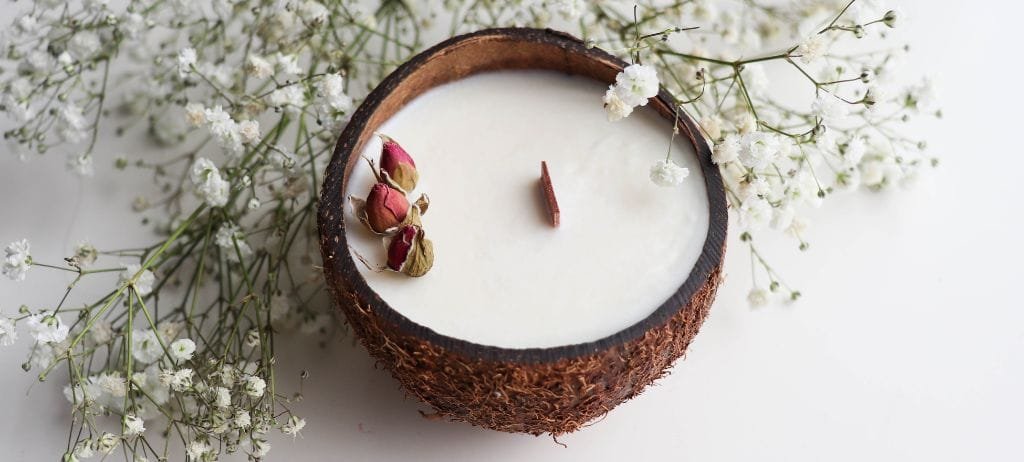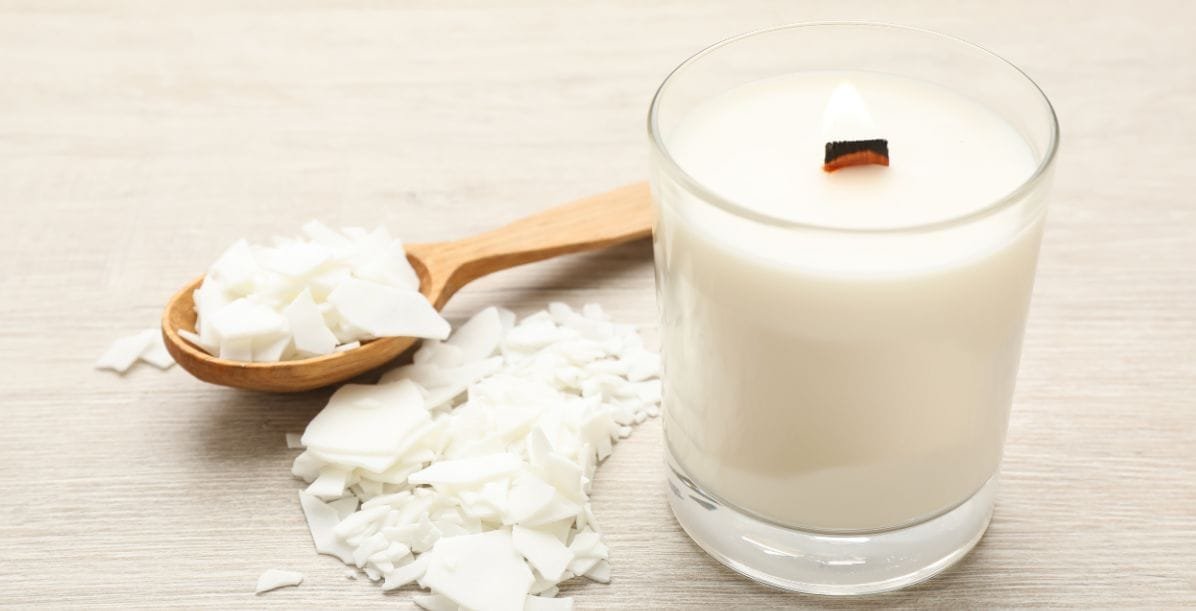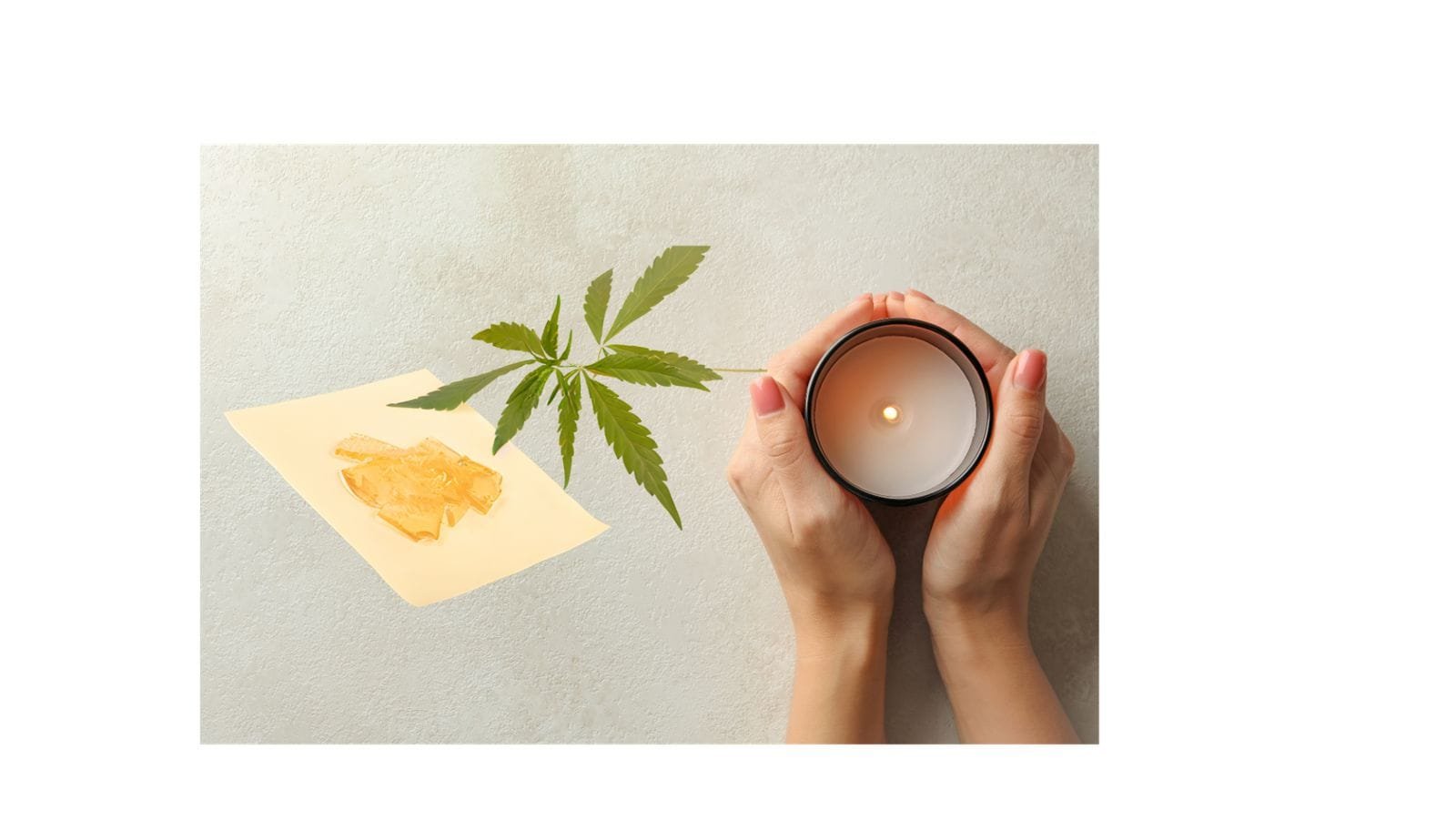When selecting a candle, it’s important to consider its wax composition. The different candle wax types available not only influence burn time and scent throw but also impact indoor air quality. Understanding these options helps you choose the perfect candle for your needs.
Types of Waxes Used In Candle Making

Why Understanding Candle Wax Matters?
Understanding the different types of wax used in candles empowers you to make informed choices based on your priorities, as each type contributes to your candle experience. Here’s how knowing the wax type can impact your candle experience:
Burn Time: Different candle wax types have varying burn times.
Scent Throw: The type of wax affects how well a candle releases its fragrance.
Additives: Knowing the candle wax types helps choose candles without harmful additives.
Fragrance Type: Wax type can affect fragrance oil compatibility.
Wick Material: Wax type determines the best wick size and material.
Sustainability: Choosing natural candle wax types over petroleum-based wax can help maintain the environment.
Price: Generally, paraffin wax candles are less expensive than natural wax candles.
8 Popular Candle Wax Types: Their Pros and Cons
Paraffin Wax
Majority of candles are created from paraffin wax, which is petroleum-based. As a byproduct of gasoline, caution should be taken with paraffin candles since this kind of wax releases hazardous VOCs into the air when burned. These chemicals can include cancer-causing agents such as alkanes, acetone, benzene, and toluene – which are also found in diesel fuel emissions and linked with allergies, asthma attacks, and skin conditions.
Are All Paraffin Wax Candles Toxic?
Paraffin Wax Candles and VOCs
The majority of candles are made from paraffin wax, a byproduct of petroleum processing. When burned, paraffin wax candles emit volatile organic compounds (VOCs) into the air. These VOCs can irritate the eyes, nose, and throat, and may trigger asthma symptoms in people with sensitivities.
Note that VOC emissions from paraffin wax candles are unlikely to be highly toxic in well-ventilated spaces. For those with respiratory sensitivities, it is recommended to use paraffin wax candles in well-ventilated areas. This minimizes exposure to VOCs and makes breathing more comfortable.
Paraffin wax is often blended with other waxes like soy or beeswax. Some of these blends can improve burning characteristics, fragrance throw, and even reduce overall VOC emissions. While paraffin wax itself isn’t necessarily the most hazardous element on the market, using candles in ventilated areas remains a good practice, regardless of wax type.
Paraffin wax candles usually contain synthetic “fragrances”, which emit VOCs. It’s wise to choose candles made with natural essential oils if fragrance is a priority, as they tend to have a lower VOC content.
Pros:
- Inexpensive
- Easy to work with
- Has a good burn time and scent throw
- Widely available
- Can be used to make a variety of different types of candles, including pillar candles, votive candles, and taper candles.
Cons:
- Made from petroleum
- Can release harmful toxins into the air when burned
- Not biodegradable, made from non-renewable petroleum, which isn’t great for the environment. Plus, it can produce soot when burned.
- Can be difficult to clean up if spilled
Beeswax

Honeybee wax comes from honeybees, is natural, and is the healthiest wax on the market. Besides having a lovely, subtle scent, it creates a strong, long-lasting flame. Despite being more expensive than other candles, it burns longer and releases a honey-like scent that cleanses odors in the air.
Making your own beeswax candle is easier than you may think, and adding some pure essential oils to them will give it a lovely scent. Here’s how to make your own beeswax candle using pure essential oils.
Pros
Natural byproduct from bees, so it’s renewable and eco-friendly.
Creates less soot and toxins compared to paraffin wax.
Produces negative ions, which help to purify the air
Long burn time
Pleasant honey scented candles
Cons
Tends to be pricier than other candle wax types.
Scent might be a bit lighter than you’d get with other waxes.
Can be difficult to find
Coconut wax

This wax is made from coconut husks and has a creamy texture. These candles are luxurious and have a smooth, white finish just like coconut oil. Beyond their beauty, coconuts are an ecologically friendly option; they produce high yields of sustainable oil which can be ethically harvested with minimal impact on the environment.
Furthermore, coconut wax burns more slowly than other types of candle wax – so you can enjoy its warmth for longer!
Pros
A win for sustainability because it comes from coconuts, which are renewable
Burns clean and soot-free
Has a good burn time and scent throw
Is a good choice for people with allergies or sensitivities to other waxes.
Biodegradable and easy to clean up if spilled
Can be used to make candles that are vegan and cruelty-free.
Cons:
Can be more expensive than other candle wax types
Can be difficult to find
May not be as durable as other waxes
Can be difficult to work with in cold climates
Soy wax

Soy is a popular choice for candles because it is made from vegetable oils and burns slower, more evenly with very little soot and comes in different colors and scents. As a renewable resource, you can feel good about reducing your carbon footprint when you choose these candles.
But unfortunately, an alarming 96% of the soybeans grown worldwide are genetically modified, and that’s not even counting all of the pesticides and chemicals used in farming that may continue to lurk within processed soy. Thus, if you like to take the extra step, you can check if the brand has a USDA-certified organic soy label.
Pros:
Natural and renewable resource
Burns clean and soot-free
Has a good burn time and scent throw
Biodegradable and easy to clean up if spilled
Widely available
Can be used to make candles that are vegan and cruelty-free.
Cons:
Can be more expensive than paraffin wax
Can be difficult to work with in cold climates
Has a Frosting effect which everyone may not like.
Palm wax

Palm wax candles have a crystallized look when cooled, offer long burn times, and retain strong fragrances. However, their association with deforestation in palm oil plantations, particularly in Southeast Asia, raises environmental concerns.
Deforestation threatens species like orangutans and causes extensive environmental damage in Malaysia and Indonesia. The environmental impact of palm oil makes palm wax unsustainable despite its benefits like scent retention and heat resistance.
Pros:
Firm texture that makes it a breeze to use in candle-making.
Has a long burn time and strong scent throw
Biodegradable
Cons:
Not a renewable resource
Production of palm oil leads to deforestation and habitat loss.
Scent might not be as strong as some other waxes.
Linked environmental damage.
Can be more expensive than other waxes
Hemp wax

Pros:
Hemp is a highly renewable plant, making it an eco-friendly choice.
Hemp cultivation requires minimal water, pesticides, and synthetic fertilizers compared to many other crops.
Burns clean and soot-free
Has a good burn time and scent throw
Biodegradable and easy to clean up if spilled
Vegan and cruelty-free
Depending on the extraction process, hemp-derived products may contain cannabinoids like CBD, offering potential therapeutic effects.
Cons:
Newer type of wax, so may not be as widely available as other waxes
Extracting wax from hemp can be a complex process, requiring specialized equipment and knowledge.
Can be more expensive than other waxes.
Rapeseed wax

Rapeseed wax (Canola wax) is a newer type of scented candle wax that offers superior scent throw and burning time, as well as greater scent retention. Many independent retailers particularly those in Europe are now turning to rapeseed/canola wax since it is more sustainable than soy-based candles.
It is a brilliant yellow flowering plant from the mustard or cabbage family and provides an eco-friendly alternative to mineral waxes. Not only does it produce less of a carbon footprint due to its local production, but this renewable resource also emits a strong fragrance, creamy texture and burns slowly over time.
Pros:
Sustainable and eco-friendly
Has a good burn time and scent throw
Biodegradable and easy to clean up if spilled
Is a good choice for people who are looking for a sustainable and eco-friendly candle.
Can be used to make candles that have a variety of different colors and finishes.
Cons:
Newer type of wax, so may not be as widely available as other waxes
Can be more expensive than other waxes
Rice bran wax

Pros:
Made from rice bran oil, it’s another renewable option
Burns clean and soot-free
Has a good burn time and scent throw
Biodegradable and easy to clean up if spilled
Vegan and cruelty-free
Sustainable and eco-friendly
Non-toxic and non-allergenic
Has a subtle rice scent
Cons:
Newer type of wax, so may not be as widely available.
Like rapeseed wax, it might not be as widespread or recognized. Also, its scent might not be as strong as some other waxes.
FAQ’S

Burn time: Some waxes, such as beeswax and coconut wax, have a longer burn time than others, such as paraffin wax.
Scent throw: Some waxes, such as soy wax and rapeseed wax, have a stronger scent throw than others, such as beeswax.
Price: Some waxes, such as paraffin wax and soy wax, are more affordable than others, such as beeswax and coconut wax.
- Consider the impact on indoor air quality when purchasing candles.
Yes, natural waxes such as soy or beeswax burn slower than paraffin wax, providing extended enjoyment from your candle.
Soy wax and coconut wax are renowned for their excellent scent throw, while paraffin wax may have weaker fragrance emissions.
Natural waxes are more likely to contain natural oils. This is because essential oils, which complement natural waxes, are typically used with them. In contrast, synthetic fragrances, which work better with paraffin wax, are not natural oils.
Yes, some waxes, particularly paraffin wax, may require additives to enhance burning characteristics or fragrance throw.
The type of wax influences burn time and soot production. Generally, natural waxes like soy or beeswax burn cleaner and longer than other waxes.
Non-toxic candles are healthier, emitting fewer harmful chemicals.
Not all scented candles are toxic, but some may emit harmful chemicals when burned. Candles made with natural ingredients like soy or beeswax and essential oils are generally safer options. However, candles containing synthetic waxes and fragrances may release volatile organic compounds (VOCs) and pose health risks when burned in poorly ventilated spaces.
Candle smoke can contain toxins, including VOCs, particulates matter, and harmful chemicals. Apart from paraffin-based candles, other potential sources of toxins in candle smoke include those made with synthetic fragrances, lead-core wicks (less common due to regulations), and certain dyes. Natural waxes like soy, beeswax, and vegetable-based waxes infused with essential oils can reduce pollution when burned.
Visual inspection: Look for a metal core or stiffness in the wick.
Bend test: Lead-core wicks are less pliable.
Rub test: Rub the wick on white paper; a silvery-gray residue may indicate lead.
Check manufacturer info: Look for lead-free wick statements on labels or contact the manufacturer.
In the past, some wicks were made of lead, but modern candles in reputable stores no longer contain lead wicks. To test if a candle wick contains lead:
Choose candles from trusted sources or those explicitly labeled with lead-free wicks to ensure safety.
As essential oils are made from natural sources, they offer potential therapeutic benefits over synthetic fragrances.
Toxins chemicals in candles originate from:
1. Wax: Paraffin wax releases chemicals like benzene and toluene when burned.
2. Fragrances: Synthetic fragrances may contain harmful VOCs.
3. Wicks: Lead-core wicks (now less common) emit lead when burned.
4. Dyes: Certain dyes may release toxins when candles are lit.
Non-toxic candles typically contain natural waxes (soy wax, beeswax, vegetable-based), essential oils, lead-free wicks, and no synthetic dyes. The natural properties of beeswax and low toxicity make them an ideal choice.
Point Of Alignment
The soft glow and delightful scents that candles emit can create a warm and inviting atmosphere for any ambiance or themed event. Their flickering light and soothing fragrance enhance their surroundings, complementing the mood you want to create. Now that you are familiar with different wax types, choose candles that suit your needs the best.






